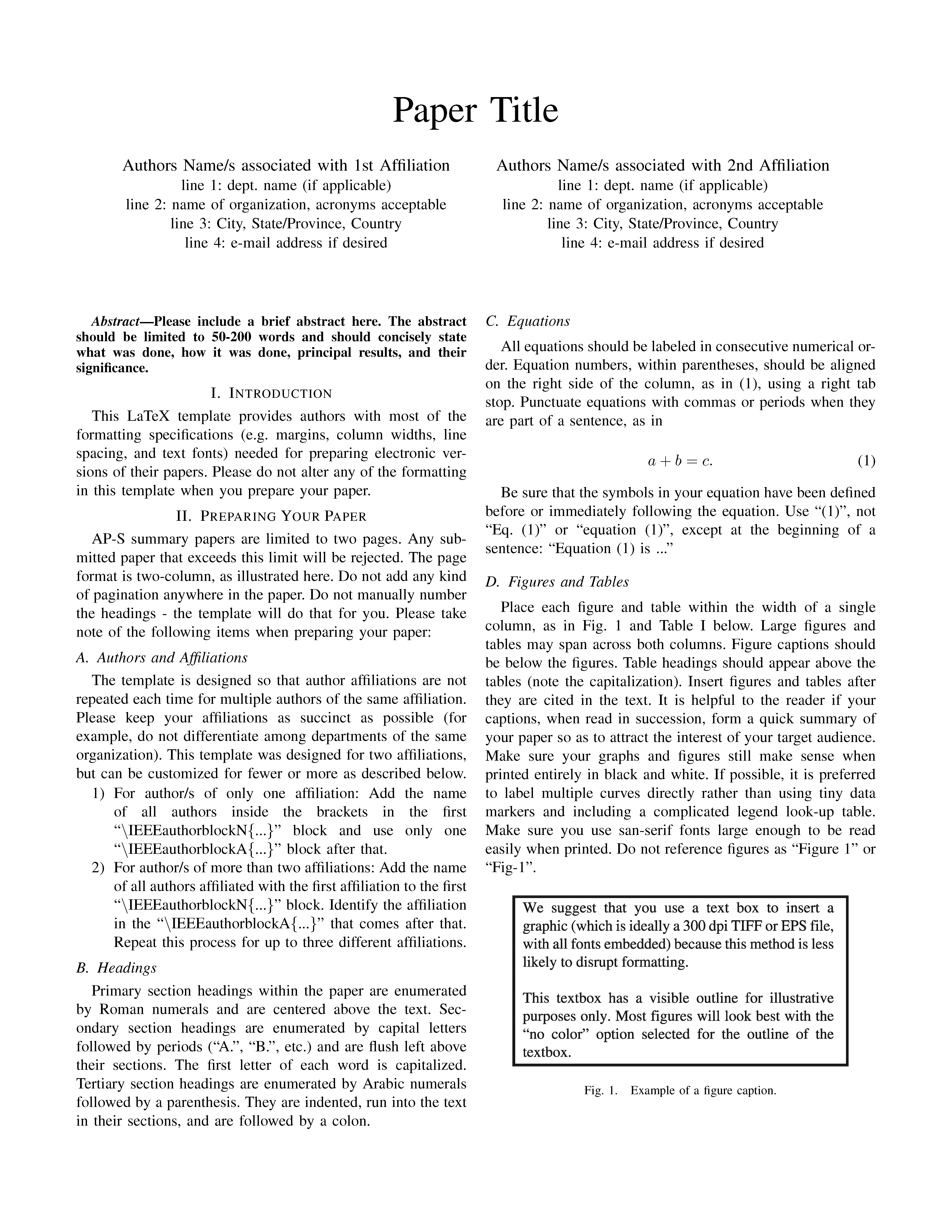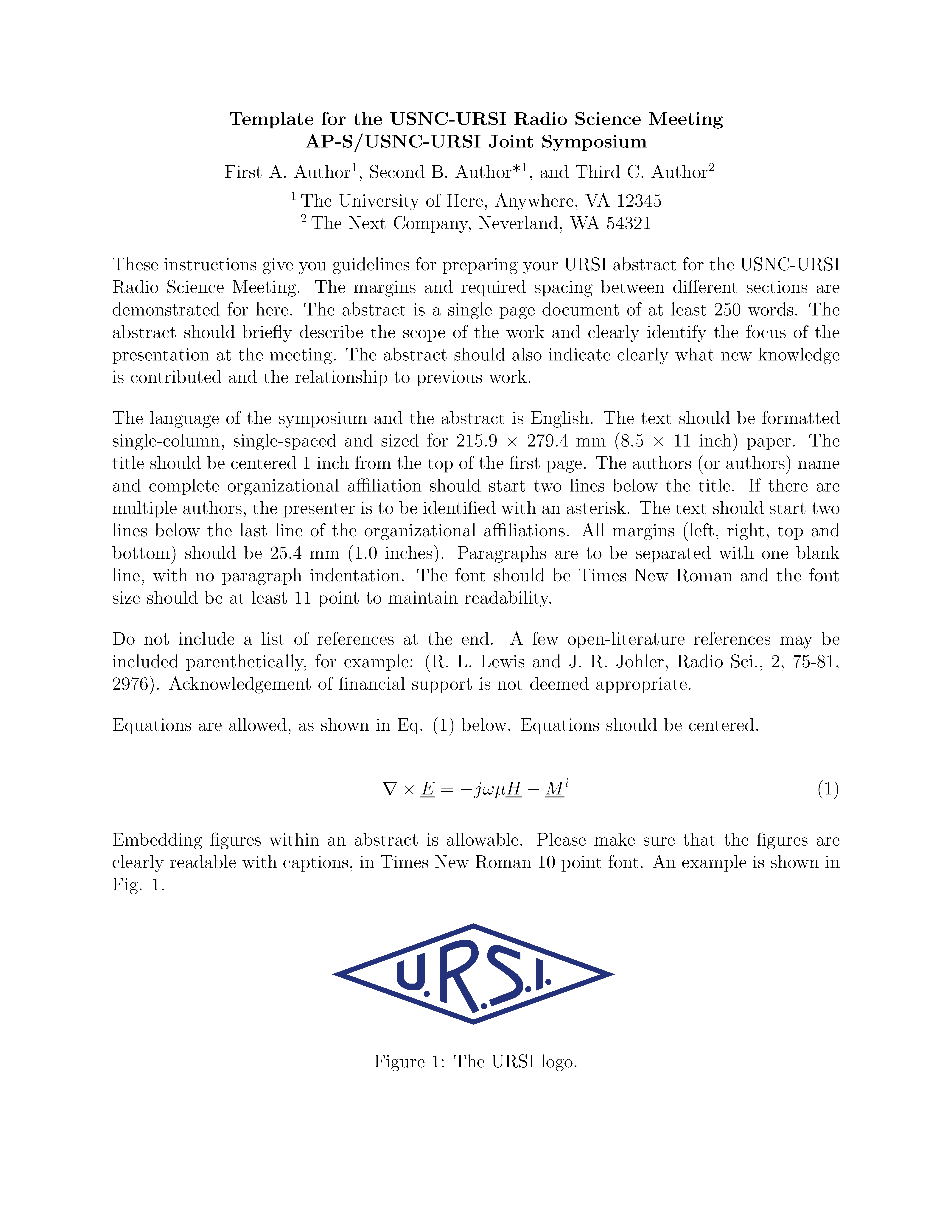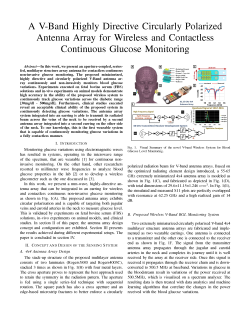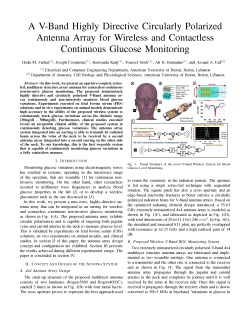If you would like an invitation confirming authorship on an accepted paper on AP-S/URSI 2024 letterhead in order to begin the travel-visa application process, you may request such a letter by clicking on the link below. Invitation Letters will be sent by email at no cost.
Request an Invitation Letter (confirming authorship on an accepted paper)
All paper and abstract submissions must be received in PDF format via
this web site on or before
Sunday, 21 January, 2024 (23h 59m at International Date Line; UTC-12 hours);
this is equivalent to 6h 59m am 22 January, 2024 Eastern US Time.
Sunday, 4 February, 2024 (23h 59m at International Date Line; UTC-12 hours);
this is equivalent to 6h 59m am 5 February, 2024 Eastern US Time.
This is a
firm deadline. Papers will not be accepted after this date. Only electronic
submissions in PDF format will be accepted. Please consult this web page
for the latest instructions, templates, and format examples. Please do not
include page numbers on submitted documents. All papers must be written in
clear, idiomatic English. Papers that are not presented at the conference (i.e. no-show papers) will be excluded from IEEE Xplore (they will be removed from the proceedings before the proceedings are submitted to IEEE Xplore).
Address all AP-S and URSI correspondence, including inquiries concerning
papers, the technical program, and copyright forms, to papers@2024.apsursi.org.
For an accepted paper to be listed in the technical program, one of the authors of the paper must be registered. Authors may only register against a maximum of 2 papers. If an author has received acceptance for more than 2 papers it is recommended that a co-author registers against those papers to limit the number of presentations required by the same author. Each author/co-author must register separately. In the event that this is not possible due to funding or visa issues, another registered attendee must be identified to serve as presenter.
The language of the symposium is English. Each document that you submit (one-page abstract or two-page summary) should be formatted exactly as indicated in the corresponding template. (The templates are already written with the correct formatting, so replacing the text in the templates with your own text is an easy way to use the templates.) Please do not include page numbers on your submitted documents.
A signed (electronically) IEEE copyright form or URSI Publication Agreement must accompany all submissions. Papers submitted without copyright forms will be rejected. Instructions for electronically signing and submitting copyright forms can be found under "Steps for Submission" below.
Papers that are not presented at the conference (i.e. no-show papers) will be excluded from IEEE Xplore (they will be removed from the proceedings before the proceedings are submitted to IEEE Xplore).
By default, 2-page papers will be submitted to IEEE Xplore. Authors may optionally choose not to include the paper in IEEE Xplore.
URSI authors should choose between a one-page abstract or a two-page summary for each submission. Submitting both formats for the same paper is not allowed.
To foster active involvement of students and to ensure a future membership of highly qualified researchers in the IEEE Antennas and Propagation Society, the Society sponsors a Student Paper Competition at its annual Symposium. The complete Rules and Guidelines are available here. Questions about the competition should be e-mailed to the 2024 AP-S Student Paper Competition Coordinators (spc@2024.apsursi.org).
If you wish to participate in the student paper competition, check the appropriate box during the submission process so that you will be prompted to upload all of the required documents.
To encourage paper submissions and dialogue relating to special topics of interest to the conference attendees, the conference will include a collection of special and celebratory sessions. Information on special and celebratory sessions is available herewill be posted here soon. If you are submitting a paper to a special or celebratory session, make sure to select the appropriate session during the submission process.
| Special Sessions | |||
|---|---|---|---|
| Advanced Antenna Technology for Civilian and Defence Applications | |||
| Advanced Technologies for EMF Exposure Assessment/Prediction/Monitoring | |||
| Advances in Additively Manufactured Dielectric Antennas for Modern Communication and Sensing Systems | |||
| AMTA Session - New developments in Antenna Measurements | |||
| Application of Electromagnetic Information Theory in next-generation wireless communication | |||
| Beam-Scanning Antennas for Next-Generation Wireless and Satellite Communications at mm-Waves and Beyond | |||
| Electromagnetic solutions for advanced and emerging RFID systems | |||
| High Sensitivity Feeds and Antenna Arrays for Radio Astronomy and Remote Sensing | |||
| IEEE AP-S Industry Initiative Session: Antennas for Future Communication Networks | |||
| Innovative Antenna Solutions for Next-Gen Non-Terrestrial Networks | |||
| Intelligent Reflecting Surfaces and Programmable Metasurfaces: Enabling the Future of 5G and 6G Communications | |||
| Machine‐Learning as Applied to EM ‐ Trends, Advances, and Applications | |||
| Maximizing the societal impact of wireless connectivity by bridging new technologies and social science | |||
| Medical applications of microwaves: from emerging trends to pathways for clinical application | |||
| Multi-functional Reconfigurable Surfaces For Next-Generation Sensing and Communications | |||
| Quantum Technology Related to Electromagnetics | |||
| Quantum/Atom Based Electric and Magnetic Field Sensors | |||
| Recent Advances in the Numerical Synthesis of Metasurfaces | |||
| Safety Aspects of Wearable and Implanted Antennas and Sensors | |||
| The Latest Developments for Automotive Antennas | |||
| Celebratory Sessions | |||
| Advancing Electromagnetic Frontiers in Antennas and Propagation: A Centenary Tribute to Leopold B. Felsen | |||
| Celebrating Prof. Constantine A. Balanis' 85th Birthday and Contributions to Antennas and Propagation | |||
| Mathematical Advances in Theoretical and Computational Electromagnetics: a Tribute to Prof. Zich | |||
| Special Session in Honor of Dr. Arthur D. Yaghjian for his 80th Birthday | |||
| Technical and Professional Advancements in Antennas, Propagation, and Radio Science: In Memory of W. Ross Stone | |||
| Understanding Our History | |||
| Focused Sessions | |||
|
Authors are also encouraged to submit papers on the following focused sessions. Please, submit your paper as regular paper by using the suggested AP-S/URSI topic and contact the proposer(s) if you are willing to submit a paper in focused sessions. | |||
| Title | Proposer | Suggested AP-S/URSI topic | |
| Physics-assisted learning and optimization techniques for Inverse Problems | Martina Teresa Bevacqua | martina.bevacqua@unirc.it, scapaticci.r@irea.cnr.it, santi.pavone@unict.it | AP-S AP-S.5.44: Inverse scattering and imaging URSI C.2: Computational imaging and inverse methods |
| Non-destructive sensing and imaging: From mm to optical waves | Maria Antonia Maisto | Mariaantonia.maisto@unicampania.it, loreto.didonato@unict.it | AP-S AP-S.5.44: Inverse scattering and imaging URSI B.2.7: Imaging, inverse scattering, and remote sensing |
| Advanced Materials and Manufacturing of Antennas and Microwave Components for Sensing and Communication Applications | Gaetano Marrocco | gaetano.marrocco@uniroma2.it, Mohammad.zarifi@ubc.ca | AP-S AP-S.6.52: 3D printed antennas and structures URSI D.10: IoT and RFID antennas, circuits, and systems |
| Challenges, advances and future trends on emerging applications of Radar Imaging | Guillermo Alvarez-Narciandi | g.alvarez-narciandi@qub.ac.uk, m.garcia-fernandez@qub.ac.uk, okan.yurduseven@qub.ac.uk | AP-S AP-S.6.50: Antennas on platforms and in specialized environments URSI C.5: Radar systems, target detection, localization, and tracking |
| New Paradigms in Electromagnetic Identification and sensing | Cecilia Occhiuzzi | Cecilia.occhiuzzi@uniroma2.it, Simon.hemour@u-bordeaux.fr | AP-S AP-S.6.53: RFID antennas and systems URSI C.6.1: Internet of Things |
| Non-LTI Electrically Small Antennas | Carl Pfeiffer | carlpfei@umich.edu, bae-ian.wu.1@us.af.mil | AP-S AP-S.6: Antenna Applications and Emerging Technologies URSI B.1 Antennas |
| Inverse Design of Antennas, Arrays and Metasurfaces | Qi Wu | qiwu@seu.edu.cn, zs9193@princeton.edu, chaoqianzju@zju.edu.cn | AP-S AP-S.4.37: Optimization methods in EM designs |
| Novel Physical Layer Technologies for Covert Communications | Fikadu Dagefu | fikadu.t.dagefu.civ@army.mil, saraband@umich.edu | AP-S AP-S.2.18: Reconfigurable and adaptive antennas and arrays URSI B.1.2: Antenna arrays and systems |
| Antennas for Planetary Exploration | Avinash Sharma | avinash.sharma@jhuapl.edu | URSI B.1 Antennas |
| New Applications of Characteristic Mode Analysis to Antenna System Design | Buon Kiong Lau | Buon_Kiong.Lau@eit.lth.se, Yi.Huang@liverpool.ac.uk | AP-S AP-S.4.29: Computational electromagnetics |
| Antennas and associated techniques for RF Energy Harvesting and Wireless Power Transfer Systems | Mohammad Hashmi | mohammad.hashmi@nu.edu.kz, nasimuddin@i2r.a-star.edu.sg, merih.palandoken@ikc.edu.tr | AP-S AP-S.6.54: Wireless power transmission and harvesting |
| Next-Generation Antenna Technologies for New Space Satellite Communications and Beyond 5G | Karu Esselle | karu.esselle@uts.edu.au, khushboo.singh@uts.edu.au, dushmantha.thalakotuna@uts.edu.au | AP-S AP-S.6.49: Satellite antennas URSI B.1.4: Antenna feeds and reflector and reflectarray antennas |
| Rays and Beams in EM Theory and Applications | Ludger Klinkenbusch | klinkenbusch@tf.uni-kiel.de, giuliano.manara@unipi.it, pathakph@gmail.com | AP-S AP-S.4.30: High-frequency and asymptotic methods URSI B.3.11: Computational electromagnetics, analysis, and optimization |
After uploading your paper, you will be directed to the IEEE Electronic Copyright system, which will walk you through electronically signing the appropriate IEEE copyright form.
Be sure to have your Publish-ready 2-column, 2-page AP-S Paper ready.

Be sure to have your Publish-ready 1-column, 1-page URSI Abstract ready.

Be sure to have your Publish-ready 2-column, 2-page URSI Paper ready.

Be sure to have ALL of the required files ready.
| Blind, 2-column, 2-page AP-S Paper, NO AUTHOR-IDENTIFYING INFORMATION |  |
This document will be judged for the SPC. You need BOTH this anonymized paper, AND the publish-ready non-anonymized paper. |
| Publish-ready, 2-column, 2-page AP-S Paper, WITH FULL AUTHOR LISTING AND REFERENCES |  |
This document will be published in the proceedings, if accepted. You need BOTH this publish-ready paper, AND the anonymized paper. |
| For consideration in the student paper competition, the student must be the only student author and must be first author on the paper. The primary advisor of the student must submit an attestation that the paper is eligible for the competition. |
Collect the required documents, then return to this page.
| Blind, 2-column, 2-page AP-S Paper, NO AUTHOR-IDENTIFYING INFORMATION |  |
This document will be judged for the SPC. You need BOTH this anonymized paper, AND the publish-ready non-anonymized paper. |
| Publish-ready, 2-column, 2-page AP-S Paper, WITH FULL AUTHOR LISTING AND REFERENCES |  |
This document will be published in the proceedings, if accepted. You need BOTH this publish-ready paper, AND the anonymized paper. |
| For consideration in the student paper competition, the student must be the only student author and must be first author on the paper. The primary advisor of the student must submit an attestation that the paper is eligible for the competition. |
Be sure to have ALL of the required files ready.
| Blind, 2-column, 2-page AP-S Paper, NO AUTHOR-IDENTIFYING INFORMATION |  |
This document will be judged for the SPC. You need BOTH this anonymized paper, AND the publish-ready non-anonymized paper. |
| Publish-ready, 2-column, 2-page AP-S Paper, WITH FULL AUTHOR LISTING AND REFERENCES |  |
This document will be published in the proceedings, if accepted. You need BOTH this publish-ready paper, AND the anonymized paper. |
| For consideration in the student paper competition, the student must be the only student author and must be first author on the paper. The primary advisor of the student must submit an attestation that the paper is eligible for the competition. |